Midweek Review
Closure of Norwegian Embassy in Colombo and other matters (Part II)

Wartime Defence Secretary Gotabaya Rajapaksa is one of those who strongly believed that the LTTE could be defeated. The Gajaba Regiment veteran didn’t mince his words when he met Norwegian officials on April 06, 2006 in the run-up to the closure of the Mavil-aru sluice gates in the third week of July 2006. According to a NorwegianForeign Ministry document in the public domain: “On April 06, 2006, Hanssen-Bauer and Brattskar had a tense meeting with Defence Secretary Gotabaya Rajapaksa. In response to a question about whether the ethnic and political problems in Sri Lanka could be solved by military means, Gotabaya answers, ‘yes’. The LTTE launched Eelam War IV in August 2006. Within two years and 10 months the Sri Lankan military brought the war to a successful end.
By Shamindra Ferdinando
Colombo-based Norwegian diplomats burnt their fingers by seeking information from the Maldivian High Commission in Colombo as regards an Indian fishing craft (Sri Krishna) that had been commandeered by Sea Tigers and was intercepted and sunk by the Maldivian Coast Guard in May 2007.
The Norwegian Embassy reached the Maldivian HC soon after the Maldivians intercepted ‘Sri Krishna’ that was reported missing several days before while fishing in Indian waters.
The Island last week dealt with the Norwegian decision to close down its diplomatic mission in Colombo next year, two decades after Oslo arranged a highly controversial secret Ceasefire Agreement (CFA) (Not even the then President Chandrika Kumaratunga was aware of it till it had been signed) between the Government of Sri Lanka and the Liberation Tigers of Tamil Eelam (LTTE). The US, EU, Japan and Norway functioned as Co-Chairs to the peace process.
The Norwegian effort received the backing of New Delhi though the Indians were skeptical. Nevertheless, they fully cooperated.
The LTTE quit the negotiating table in April 2003, one year and three months after the signing of the CFA. But, the Norwegians went out of their way to appease the LTTE regardless of the consequences. The diplomatic intervention made on behalf of the Tigers involved in the incident in the Maldivian waters is a case in point. In a way, the LTTE and its sidekick the Tamil National Alliance failed to utilize the Norwegian effort to advance the peace process, whether sincere or not. Instead, the LTTE exploited the Norwegian initiative so much that the negotiating process finally collapsed. Their strategy undermined the then Premier Ranil Wickremesinghe, who meekly towed the Norwegian line. On the other hand, their actions bolstered the nationalist groups and those opposed to the Norwegian questionable initiatives.
Dissolution of Parliament and calling for fresh parliamentary elections in April 2004 should be examined against the backdrop of utterly irresponsible LTTE strategy and its appeasers. However, the elections allowed the TNA, with the LTTE openly stuffing ballot boxes in areas it controlled, to secure the lion’s share of seats in the then amalgamated Northern and Eastern Provinces. Peace Co-Chair EU in its Election Observation report declared that the TNA colluded with the LTTE. Unfortunately, Co-Chairs, including the EU didn’t take the report into consideration.
The incident in the Maldivian waters should be examined basically against the backdrop of the overall deterioration of the situation for want of clear guidelines to handle the peace process.
The Norwegians wouldn’t have intervened without being asked by the LTTE with a nod from a powerful Western interest. We must also note that Norwegian peacemaking efforts in Palestine with obvious American backing that brought about the Oslo Accord with much promise fared even worse with the Palestinians continuing to be humiliated and pasted by the Israelis almost on a daily basis. Where the hell is UNHRC? No war crimes there on your watch Michelle Bachelet? At least the UN should have given her a Nelsonian eye patch.
The Norwegian mission here definitely cleared its move with Oslo. However, by the time they got in touch with the Maldivian HC, Male had cleared Sri Lankan Navy intelligence to interrogate the apprehended LTTE cadres in the custody of the Maldivian. The Island reported the Norwegian intervention in its May 26, 2007 edition. The LTTE had used the ill-fated vessel to transfer weapons from its floating armories to Wanni and was on such a mission when the Maldivians intervened.
At the time the Maldivians sank Sri Krishna, Tamil Nadu had accused the Sri Lanka Navy of destroying that particular vessel. What Tamil Nadu as well as India never expected was another country intervening in the clandestine LTTE arms smuggling operation.
The Maldivian Coast Guard made the intervention on May 16, 2007. The Maldivian Coast Guard engaged a vessel carrying the Sri Lankan flag after the latter fired at a Maldivian fishing craft.
Following a 12-hour standoff, the Maldivians sank the craft flying the Sri Lankan flag.
Interestingly, there had been some Indian naval personnel onboard the Maldivian craft engaged in the operation against the Tiger commandeered vessel.
The LTTE would have never expected its cadres who commandeered the vessel to surrender as they are noted for biting their cyanide vials to prevent capture. The Maldivians however rescued five Tigers who jumped overboard from the sinking vessel, subsequently identified as Sri Krishna. The rescued men told the Maldivians and their Indian instructors (The Indians were helping the Maldivian Coast Guard personnel to familiarize with CG vessel Huravee, gifted by New Delhi to Male) the circumstances under which they were found in Maldivian waters, while engaged in transferring armaments from a floating warehouse.
Sri Krishna’s skipper, Simon Soza had been among the five rescued by the Maldivians. The Sea Tigers admitted that the remaining Indians were being held in a camp in the Vanni (Maldives sinks Indian craft hijacked by Sea Tigers – The Island May 18, 2007).
The sinking of the Sri Krishna was the second high profile incident involving an Indian trained terrorist group in the Maldivian territory. The raid on Male during the first week of November, 1988 by sea borne PLOTE (People’s Liberation Tigers of Tamil Eelam) terrorists at the behest of a Colombo-based Maldivian businessman, Abdulla Luthufee was the first. Interestingly, the Indian Navy sank MV Progress Light commandeered by Luthufee’s mercenaries while trying to reach Sri Lankan waters.
Former Foreign Minister Prof. G.L. Peiris, who led the then UNP government’s negotiating team for talks with the LTTE in 2002-2003 period, appreciated the role played by the Scandinavian country.
GL, Palihakkara, Salter,Jehan comment

Mark Salter
Prof. Peiris, now a leading member in one of the SLPP rebel groups said: “The Norwegian government was significantly involved in the economic development of Sri Lanka, long before its association with the peace process. In particular, there had been substantial Norwegian support for infrastructure development, especially rural roads in the South of Sri Lanka, in addition to assistance in the fisheries sector, human resources development and community work of various kinds.
In the aftermath of its facilitation role in the peace process in the late 1990s and early in the present century, the government of Norway commissioned an independent evaluation of their role here with a view to ascertaining its strengths and weaknesses. I believe this study led to more useful insights.
We regret the decision to close down the embassy in Colombo for the time being, but understand that it is part of a worldwide evaluation process.
The government of Norway has announced its commitment to and support for the people of Sri Lanka will continue. We appreciate this assurance.”
In response to The Island query regarding the Norwegian pull out, Executive Director of the National Peace Council (NPC), Dr. Jehan Perera has sent us the following statement: “The departure of the Norwegian Embassy from Sri Lanka is a big loss to us. This is a time when we need all the assistance and friendship we can from the international community, especially those who have helped us in the past. The Ambassador has stated that Norway will continue to provide Sri Lanka with assistance and will engage in development activities. However, Sri Lanka will lose out because remote support is not the same as in-country support where Norwegian diplomats and embassy staff are in constant interaction with Sri Lankan people. We also need to acknowledge the huge investment Norway made to help us resolve our ethnic war through negotiations and a political solution. They supported organisations such as the National Peace Council to build bridges between the communities, which we continue to do. Norwegian support for peace-building work got reduced after the failure of the ceasefire agreement and peace process. NPC did not receive Norwegian financial support over the past decade. But the capacity for peace-building work that Norway supported us to achieve, and which continues to remain with us, is a cause for gratitude and we regret very much the closure of their embassy.”
The author of ‘To End a Civil War: Norway’s Peace Engagement in Sri Lanka’ Mark Salter said: “The closure of the Norwegian Embassy in Colombo ends an important chapter in relations between the two countries. At the joint invitation of the government and the LTTE leadership, in 1999-2000 Oslo accepted the role of peace facilitator between the two parties. To their great credit, over the following decade the Norwegians stuck at their appointed ‘peace diplomacy’ task through thick and thin – possibly the most sustained instance of external engagement with a peace process to date. And this including when, in the aftermath of the return to war in autumn 2006 and the Ceasefire Agreement (CFA) the Norwegians brokered in 2002 looked increasingly dead in the water, they became the subject of increasing domestic attacks, notably by both the government itself and Sinhala nationalists who tarred them with the brush of ‘White Tigers’.
As we know, theirs (and other) peace efforts ultimately failed. A messenger, however, is only as good as the message they carry – a fact that often seems completely lost on the legions of Lankan critics of the Norwegian’s ‘messenger’ role. As Erik Solheim and others have long since acknowledged, Oslo undoubtedly made mistakes along the way – notably the failure to foster an initial bipartisan Sinhala political consensus in support of the peace process. Ultimately, however, the failure of the peace process comes down to the failure in their different ways of both parties to continue to engage seriously with the process itself.”
For those who are genuinely interested in knowing the Norwegian-led process, perusal of Salter’s work is a must. Former BBC journalist and analyst, Mark Salter who launched ‘To End a Civil War: Norway’s Peace Engagement in Sri Lanka’ in Colombo several years after Norway released ‘Pawns of Peace: Evaluation of Norwegian peace efforts in Sri Lanka (1997-2009)’ meticulously addressed the issues. Salter’s work help the readers to understand what really went wrong if the official Norwegian examination didn’t achieve what was expected. Chr. Michelsen Institute and School of Oriental and African Studies, University of London, jointly put out that report. The team responsible for the official version comprised Gunnar Sørbø, Jonathan Goodhand, Bart Klem, Ada Elisabeth Nissen and Hilde Selbervik. The Wikileaks revelations should be of pivotal importance for those keen to know the developments here.
One-time Foreign Secretary H.M.G.S. Palihakkara who served as the Governor of the Northern Province during the Yahapalana administration, has sent us the following statement in response to a query posed to him: “It does not look like a singular decision by one country, at least optics-wise, since both countries announced the intended closures within a space of a few months this year, Sri Lanka being the first in April and Norway following in September. Embassy closing of course is news one can hardly celebrate esp. in bilateral diplomacy. The notion that reciprocity is the first lesson in diplomacy still has some currency. And that factor may have weighed in at some stage of this decision-making process. However, speculating on that won’t help either side.
What is of promise is that both countries have been quick to emphasize that the decisions are derived from ‘structural’, rather than bilateral considerations and will not impinge on relations.
Sri Lanka has further qualified closure as ‘temporary’ while Norway has recommitted itself to ‘further the constructive and friendly relations’. It would be reasonable to say these relations have endured many decades and vicissitudes including a complicated and even controversial ‘peace process’ with the LTTE through a vain facilitation effort by Norway.
The Norwegian envoy in Colombo, Ambassador Trine Jøranli Eskedal in her media comments has quite professionally put these positives at a higher notch saying ‘ We will continue to maintain our warm bilateral relations with Sri Lanka and development assistance will also continue.’ So the ‘distancing’ signified by these closures at first glance, may be more apparent than real. The fact remains that SL has benefitted from several billions of NKR bilateral ODA for projects ranging from the well-known Cey-Nor in the North to extensive rural development in the South. Since modern diplomacy is often about building on what you have rather than imagining the ideal, it is up to both sides to do just that-build on the positives.”
Whatever the views expressed by interested parties regarding the planned Norwegian closure of its embassy here the fact remains the move is detrimental to Sri Lanka, especially at a time the country is experiencing its worst post-independence economic crisis. Norway spent lavishly on its Sri Lanka project. Civil society groups benefited immensely. A simmering dispute between the Norwegians and the late Dr. Kumar Rupesinghe, one of the largest beneficiaries of the Norwegian funding highlighted the controversial relationship between the embassy and the civil society. The Norwegians ended up squandering their taxpayers’ money even on the LTTE and its front organizations. That is the undeniable truth.
But, perhaps their biggest mistake that had been influenced by interested parties here was the assertion as acknowledged in ‘Pawns of Peace: Evaluation of Norwegian peace efforts in Sri Lanka (1997-2009)’ that the LTTE cannot be defeated.
The Norwegians as well as other Co- Chairs operated on the premise the Sri Lankan military couldn’t match the LTTE’s strategy or the fighting will. Those who benefited from the Norwegian largesse propagated that myth wherever possible like their Western pay masters. That assessment was proved wrong in May 2009 when a soldier shot Velupillai Prabhakaran on his head on the banks of the Nanthikadal lagoon.
Features
Handunnetti and Colonial Shackles of English in Sri Lanka
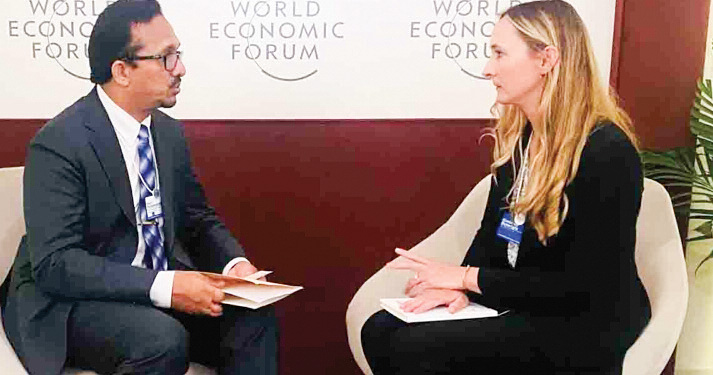
“My tongue in English chains.
I return, after a generation, to you.
I am at the end
of my Dravidic tether
hunger for you unassuaged
I falter, stumble.”
– Indian poet R. Parthasarathy
 When Minister Sunil Handunnetti addressed the World Economic Forum’s ‘Is Asia’s Century at Risk?’ discussion as part of the Annual Meeting of the New Champions 2025 in June 2025, I listened carefully both to him and the questions that were posed to him by the moderator. The subsequent trolling and extremely negative reactions to his use of English were so distasteful that I opted not to comment on it at the time. The noise that followed also meant that a meaningful conversation based on that event on the utility of learning a powerful global language and how our politics on the global stage might be carried out more successfully in that language was lost on our people and pundits, barring a few commentaries.
When Minister Sunil Handunnetti addressed the World Economic Forum’s ‘Is Asia’s Century at Risk?’ discussion as part of the Annual Meeting of the New Champions 2025 in June 2025, I listened carefully both to him and the questions that were posed to him by the moderator. The subsequent trolling and extremely negative reactions to his use of English were so distasteful that I opted not to comment on it at the time. The noise that followed also meant that a meaningful conversation based on that event on the utility of learning a powerful global language and how our politics on the global stage might be carried out more successfully in that language was lost on our people and pundits, barring a few commentaries.
Now Handunnetti has reopened the conversation, this time in Sri Lanka’s parliament in November 2025, on the utility of mastering English particularly for young entrepreneurs. In his intervention, he also makes a plea not to mock his struggle at learning English given that he comes from a background which lacked the privilege to master the language in his youth. His clear intervention makes much sense.
The same ilk that ridiculed him when he spoke at WEF is laughing at him yet again on his pronunciation, incomplete sentences, claiming that he is bringing shame to the country and so on and so forth. As usual, such loud, politically motivated and retrograde critics miss the larger picture. Many of these people are also among those who cannot hold a conversation in any of the globally accepted versions of English. Moreover, their conceit about the so-called ‘correct’ use of English seems to suggest the existence of an ideal English type when it comes to pronunciation and basic articulation. I thought of writing this commentary now in a situation when the minister himself is asking for help ‘in finding a solution’ in his parliamentary speech even though his government is not known to be amenable to critical reflection from anyone who is not a party member.
The remarks at the WEF and in Sri Lanka’s parliament are very different at a fundamental level, although both are worthy of consideration – within the realm of rationality, not in the depths of vulgar emotion and political mudslinging.
The problem with Handunnetti’s remarks at WEF was not his accent or pronunciation. After all, whatever he said could be clearly understood if listened to carefully. In that sense, his use of English fulfilled one of the most fundamental roles of language – that of communication. Its lack of finesse, as a result of the speaker being someone who does not use the language professionally or personally on a regular basis, is only natural and cannot be held against him. This said, there are many issues that his remarks flagged that were mostly drowned out by the noise of his critics.
Given that Handunnetti’s communication was clear, it also showed much that was not meant to be exposed. He simply did not respond to the questions that were posed to him. More bluntly, a Sinhala speaker can describe the intervention as yanne koheda, malle pol , which literally means, when asked ‘Where are you going?’, the answer is ‘There are coconuts in the bag’.
He spoke from a prepared text which his staff must have put together for him. However, it was far off the mark from the questions that were being directly posed to him. The issue here is that his staff appears to have not had any coordination with the forum organisers to ascertain and decide on the nature of questions that would be posed to the Minister for which answers could have been provided based on both global conditions, local situations and government policy. After all, this is a senior minister of an independent country and he has the right to know and control, when possible, what he is dealing with in an international forum.
This manner of working is fairly routine in such international fora. On the one hand, it is extremely unfortunate that his staff did not do the required homework and obviously the minister himself did not follow up, demonstrating negligence, a want for common sense, preparedness and experience among all concerned. On the other hand, the government needs to have a policy on who it sends to such events. For instance, should a minister attend a certain event, or should the government be represented by an official or consultant who can speak not only fluently, but also with authority on the subject matter. That is, such speakers need to be very familiar with the global issues concerned and not mere political rhetoric aimed at local audiences.
Other than Handunnetti, I have seen, heard and also heard of how poorly our politicians, political appointees and even officials perform at international meetings (some of which are closed door) bringing ridicule and disastrous consequences to the country. None of them are, however, held responsible.
Such reflective considerations are simple yet essential and pragmatic policy matters on how the government should work in these conditions. If this had been undertaken, the WEF event might have been better handled with better global press for the government. Nevertheless, this was not only a matter of English. For one thing, Handunnetti and his staff could have requested for the availability of simultaneous translation from Sinhala to English for which pre-knowledge of questions would have been useful. This is all too common too. At the UN General Assembly in September, President Dissanayake spoke in Sinhala and made a decent presentation.
The pertinent question is this; had Handunetti had the option of talking in Sinhala, would the interaction have been any better? That is extremely doubtful, barring the fluency of language use. This is because Handunnetti, like most other politicians past and present, are good at rhetoric but not convincing where substance is concerned, particularly when it comes to global issues. It is for this reason that such leaders need competent staff and consultants, and not mere party loyalists and yes men, which is an unfortunate situation that has engulfed the whole government.
What about the speech in parliament? Again, as in the WEF event, his presentation was crystal clear and, in this instance, contextually sensible. But he did not have to make that speech in English at all when decent simultaneous translation services were available. In so far as content was concerned, he made a sound argument considering local conditions which he knows well. The minister’s argument is about the need to ensure that young entrepreneurs be taught English so that they can deal with the world and bring investments into the country, among other things. This should actually be the norm, not only for young entrepreneurs, but for all who are interested in widening their employment and investment opportunities beyond this country and in accessing knowledge for which Sinhala and Tamil alone do not suffice.
As far as I am concerned, Handunetti’s argument is important because in parliament, it can be construed as a policy prerogative. Significantly, he asked the Minister of Education to make this possible in the educational reforms that the government is contemplating.
He went further, appealing to his detractors not to mock his struggle in learning English, and instead to become part of the solution. However, in my opinion, there is no need for the Minister to carry this chip on his shoulder. Why should the minister concern himself with being mocked for poor use of English? But there is a gap that his plea should have also addressed. What prevented him from mastering English in his youth goes far deeper than the lack of a privileged upbringing.
The fact of the matter is, the facilities that were available in schools and universities to learn English were not taken seriously and were often looked down upon as kaduwa by the political spectrum he represents and nationalist elements for whom the utilitarian value of English was not self-evident. I say this with responsibility because this was a considerable part of the reality in my time as an undergraduate and also throughout the time I taught in Sri Lanka.
Much earlier in my youth, swayed by the rhetoric of Sinhala language nationalism, my own mastery of English was also delayed even though my background is vastly different from the minister. I too was mocked, when two important schools in Kandy – Trinity College and St. Anthony’s College – refused to accept me to Grade 1 as my English was wanting. This was nearly 20 years after independence. I, however, opted to move on from the blatant discrimination, and mastered the language, although I probably had better opportunities and saw the world through a vastly different lens than the minister. If the minister’s commitment was also based on these social and political realities and the role people like him had played in negating our English language training particularly in universities, his plea would have sounded far more genuine.
If both these remarks and the contexts in which they were made say something about the way we can use English in our country, it is this: On one hand, the government needs to make sure it has a pragmatic policy in place when it sends representatives to international events which takes into account both a person’s language skills and his breadth of knowledge of the subject matter. On the other hand, it needs to find a way to ensure that English is taught to everyone successfully from kindergarten to university as a tool for inclusion, knowledge and communication and not a weapon of exclusion as is often the case.
This can only bear fruit if the failures, lapses and strengths of the country’s English language teaching efforts are taken into cognizance. Lamentably, division and discrimination are still the main emotional considerations on which English is being popularly used as the trolls of the minister’s English usage have shown. It is indeed regrettable that their small-mindedness prevents them from realizing that the Brits have long lost their long undisputed ownership over the English language along with the Empire itself. It is no longer in the hands of the colonial masters. So why allow it to be wielded by a privileged few mired in misplaced notions of elitism?
Features
Finally, Mahinda Yapa sets the record straight

Clandestine visit to Speaker’s residence:
Finally, former Speaker Mahinda Yapa Abeywardena has set the record straight with regard to a controversial but never properly investigated bid to swear in him as interim President. Abeywardena has disclosed the circumstances leading to the proposal made by external powers on the morning of 13 July, 2022, amidst a large scale staged protest outside the Speaker’s official residence, situated close to Parliament.
Lastly, the former parliamentarian has revealed that it was then Indian High Commissioner, in Colombo, Gopal Baglay (May 2022 to December 2023) who asked him to accept the presidency immediately. Professor Sunanda Maddumabandara, who served as Senior Advisor (media) to President Ranil Wickremesinghe (July 2022 to September 2024), disclosed Baglay’s direct intervention in his latest work, titled ‘Aragalaye Balaya’ (Power of Aragalaya).
Prof. Maddumabandara quoted Abeywardena as having received a startling assurance that if he agreed to accept the country’s leadership, the situation would be brought under control, within 45 minutes. Baglay had assured Abeywardena that there is absolutely no harm in him succeeding President Gotabaya Rajapaksa, in view of the developing situation.
The author told the writer that only a person who had direct control over the violent protest campaign could have given such an assurance at a time when the whole country was in a flux.
One-time Vice Chancellor of the Kelaniya University, Prof. Maddumabandara, launched ‘Aragalaye Balaya’ at the Sri Lanka Foundation on 20 November. In spite of an invitation extended to former President Gotabaya Rajapaksa, the ousted leader hadn’t attended the event, though UNP leader Ranil Wickremesinghe was there. Maybe Gotabaya felt the futility of trying to expose the truth against evil forces ranged against them, who still continue to control the despicable agenda.
Obviously, the author has received the blessings of Abeywardena and Wickremesinghe to disclose a key aspect in the overall project that exploited the growing resentment of the people to engineer change of Sri Lankan leadership.
The declaration of Baglay’s intervention has contradicted claims by National Freedom Front (NFF) leader Wimal Weerawansa (Nine: The hidden story) and award-winning writer Sena Thoradeniya (Galle Face Protest: System change for anarchy) alleged that US Ambassador Julie Chung made that scandalous proposal to Speaker Abeywardena. Weerawansa and Thoradeniya launched their books on 25 April and 05 July, 2023, at the Sri Lanka Foundation and the National Library and Documentation Services Board, Independence Square, respectively. Both slipped in accusing Ambassador Chung of making an abortive bid to replace Gotabaya Rajapaksa with Mahinda Yapa Abeywardena.
Ambassador Chung categorically denied Weerawansa’s allegation soon after the launch of ‘Nine: The hidden story’ but stopped short of indicating that the proposal was made by someone else. Chung had no option but to keep quiet as she couldn’t, in response to Weerawansa’s claim, have disclosed Baglay’s intervention, under any circumstances, as India was then a full collaborator with Western designs here for its share of spoils. Weerawansa, Thoradeniya and Maddumabandara agree that Aragalaya had been a joint US-Indian project and it couldn’t have succeeded without their intervention. Let me reproduce the US Ambassador’s response to Weerawansa, who, at the time of the launch, served as an SLPP lawmaker, having contested the 2020 August parliamentary election on the SLPP ticket.
“I am disappointed that an MP has made baseless allegations and spread outright lies in a book that should be labelled ‘fiction’. For 75 years, the US [and Sri Lanka] have shared commitments to democracy, sovereignty, and prosperity – a partnership and future we continue to build together,” Chung tweeted Wednesday 26 April, evening, 24 hours after Weerawansa’s book launch.
Interestingly, Gotabaya Rajapaksa has been silent on the issue in his memoirs ‘The Conspiracy to oust me from Presidency,’ launched on 07 March, 2024.
What must be noted is that our fake Marxists, now entrenched in power, were all part and parcel of Aragalaya.
A clandestine meeting
Abeywardena should receive the appreciation of all for refusing to accept the offer made by Baglay, on behalf of India and the US. He had the courage to tell Baglay that he couldn’t accept the presidency as such a move violated the Constitution. In our post-independence history, no other politician received such an offer from foreign powers. When Baglay stepped up pressure, Abeywardena explained that he wouldn’t change his decision.
Maddumabandara, based on the observations made by Abeywardena, referred to the Indian High Commissioner entering the Speaker’s Official residence, unannounced, at a time protesters blocked the road leading to the compound. The author raised the possibility of Baglay having been in direct touch with those spearheading the high profile political project.
Clearly Abeywardena hadn’t held back anything. The former Speaker appeared to have responded to those who found fault with him for not responding to allegations, directed at him, by revealing everything to Maddumabandara, whom he described in his address, at the book launch, as a friend for over five decades.
At the time, soon after Baglay’s departure from the Speaker’s official residence, alleged co-conspirators Ven. Omalpe Sobitha, accompanied by Senior Professor of the Sinhala Faculty at the Colombo University, Ven. Agalakada Sirisumana, health sector trade union leader Ravi Kumudesh, and several Catholic priests, arrived at the Speaker’s residence where they repeated the Indian High Commissioner’s offer. Abeywardena repeated his previous response despite Sobitha Thera acting in a threatening manner towards him to accept their dirty offer. Shouldn’t they all be investigated in line with a comprehensive probe?
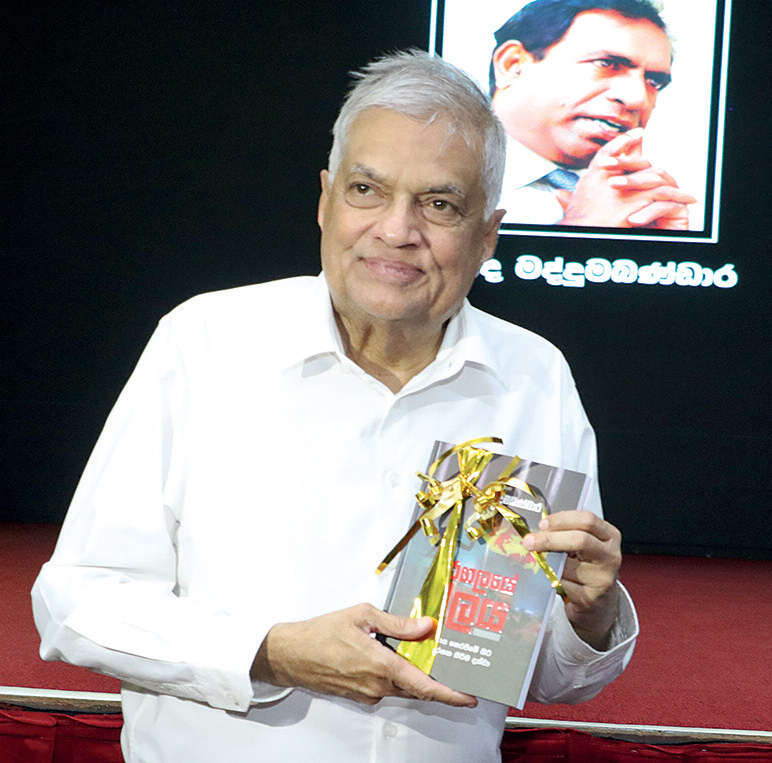
Ex-President Wickremesinghe with a copy of Aragalaye Balaya he received from its author, Prof. Professor Sunanda Maddumabandara, at the Sri Lanka Foundation recently (pic by Nishan S Priyantha)
On the basis of what Abeywardena had disclosed to him, Maddumabanadara also questioned the circumstances of the deployment of the elite Special Task Force (STF) contingent at the compound. The author asked whether that deployment, without the knowledge of the Speaker, took place with the intervention of Baglay.
Aragalaye Balaya
is a must read for those who are genuinely interested in knowing the unvarnished truth. Whatever the deficiencies and inadequacies on the part of the Gotabaya Rajapaksa administration, external powers had engineered a change of government. The writer discussed the issues that had been raised by Prof. Maddumabandara and, in response to one specific query, the author asserted that in spite of India offering support to Gotabaya Rajapaksa earlier to get Ranil Wickremesinghe elected as the President by Parliament to succeed him , the latter didn’t agree with the move. Then both the US and India agreed to bring in the Speaker as the Head of State, at least for an interim period.
If Speaker Abeywardena accepted the offer made by India, on behalf of those backing the dastardly US backed project, the country could have experienced far reaching changes and the last presidential election may not have been held in September, 2004.
After the conclusion of his extraordinary assignment in Colombo, Baglay received appointment as New Delhi’s HC in Canberra. Before Colombo, Baglay served in Indian missions in Ukraine, Russia, the United Kingdom, Nepal and Pakistan (as Deputy High Commissioner).
Baglay served in New Delhi, in the office of the Prime Minister of India, and in the Ministry of External Affairs as its spokesperson, and in various other positions related to India’s ties with her neighbours, Europe and multilateral organisations.
Wouldn’t it be interesting to examine who deceived Weerawansa and Thoradeniya who identified US Ambassador Chung as the secret visitor to the Speaker’s residence. Her high-profile role in support of the project throughout the period 31 March to end of July, 2022, obviously made her an attractive target but the fact remains it was Baglay who brought pressure on the then Speaker. Mahinda Yapa Abeywardena’s clarification has given a new twist to “Aragalaya’ and India’s diabolical role.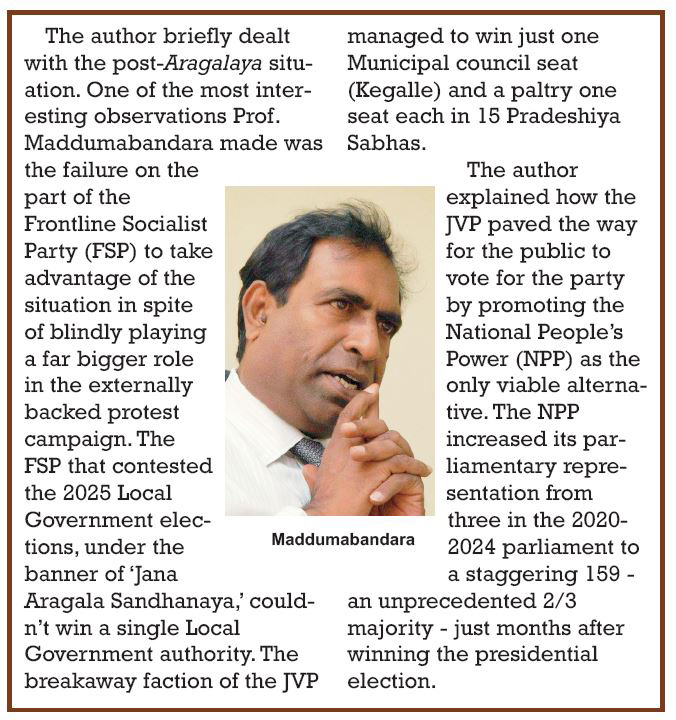
Absence of investigations
Sri Lanka never really wanted to probe the foreign backed political plot to seize power by extra-parliamentary means. Although some incidents had been investigated, the powers that be ensured that the overall project remained uninvestigated. In fact, Baglay’s name was never mentioned regarding the developments, directly or indirectly, linked to the devious political project. If not for Prof. Maddumabandara taking trouble to deal with the contentious issue of regime change, Baglay’s role may never have come to light. Ambassador Chung would have remained the target of all those who found fault with US interventions. Let me be clear, the revelation of Baglay’s clandestine meeting with the Speaker didn’t dilute the role played by the US in Gotabaya Rajapaksa’s removal.
If Prof. Maddumabandara propagated lies, both the author and Abeywardana should be appropriately dealt with. Aragalaye Balaya failed to receive the desired or anticipated public attention. Those who issue media statements at the drop of a hat conveniently refrained from commenting on the Indian role. Even Abeywardena remained silent though he could have at least set the record straight after Ambassador Chung was accused of secretly meeting the Speaker. Abeywardena could have leaked the information through media close to him. Gotabaya Rajapaksa and Ranil Wickremesinghe, too, could have done the same but all decided against revealing the truth.
A proper investigation should cover the period beginning with the declaration made by Gotabaya Rajapaksa’s government, in April 2022, regarding the unilateral decision to suspend debt repayment. But attention should be paid to the failure on the part of the government to decide against seeking assistance from the International Monetary Fund (IMF) to overcome the crisis. Those who pushed Gotabaya Rajapaksa to adopt, what they called, a domestic solution to the crisis created the environment for the ultimate collapse that paved the way for external interventions. Quite large and generous Indian assistance provided to Sri Lanka at that time should be examined against the backdrop of a larger frightening picture. In other words, India was literally running with the sheep while hunting with the hounds. Whatever the criticism directed at India over its role in regime change operation, prompt, massive and unprecedented post-Cyclone Ditwah assistance, provided by New Delhi, saved Sri Lanka. Rapid Indian response made a huge impact on Sri Lanka’s overall response after having failed to act on a specific 12 November weather alert.
It would be pertinent to mention that all governments, and the useless Parliament, never wanted the public to know the truth regarding regime change project. Prof. Maddumabandara discussed the role played by vital sections of the armed forces, lawyers and the media in the overall project that facilitated external operations to force Gotabaya Rajapaksa out of office. The author failed to question Wickremesinghe’s failure to launch a comprehensive investigation, with the backing of the SLPP, immediately after he received appointment as the President. There seems to be a tacit understanding between Wickremesinghe and the SLPP that elected him as the President not to initiate an investigation. Ideally, political parties represented in Parliament should have formed a Special Parliamentary Select Committee (PSC) to investigate the developments during 2019 to the end of 2022. Those who had moved court against the destruction of their property, during the May 2022 violence directed at the SLPP, quietly withdrew that case on the promise of a fresh comprehensive investigation. This assurance given by the Wickremesinghe government was meant to bring an end to the judicial process.
When the writer raised the need to investigate external interventions, the Human Rights Commission of Sri Lanka (HRCSL) sidestepped the issue. Shame on the so-called independent commission, which shows it is anything but independent.
Sumanthiran’s proposal
Since the eradication of the Liberation Tigers of Tamil Eelam (LTTE) in May 2009, the now defunct Tamil National Alliance’s (TNA) priority had been convincing successive governments to withdraw the armed forces/ substantially reduce their strength in the Northern and Eastern Provinces. The Illankai Thamil Arasu Kadchi (ITAK)-led TNA, as well as other Tamil political parties, Western powers, civil society, Tamil groups, based overseas, wanted the armed forces out of the N and E regions.
Abeywardena also revealed how the then ITAK lawmaker, M.A. Sumanthiran, during a tense meeting chaired by him, in Parliament, also on 13 July, 2022, proposed the withdrawal of the armed forces from the N and E for redeployment in Colombo. The author, without hesitation, alleged that the lawmaker was taking advantage of the situation to achieve their longstanding wish. The then Speaker also disclosed that Chief Opposition Whip Lakshman Kiriella and other party leaders leaving the meeting as soon as the armed forces reported the protesters smashing the first line of defence established to protect the Parliament. However, leaders of minority parties had remained unruffled as the situation continued to deteriorate and external powers stepped up efforts to get rid of both Gotabaya Rajapaksa and Ranil Wickremesinghe to pave the way for an administration loyal and subservient to them. Foreign powers seemed to have been convinced that Speaker Abeywardena was the best person to run the country, the way they wanted, or till the Aragalaya mob captured the House.
The Author referred to the role played by the media, including social media platforms, to promote Gotabaya Rajapaksa’s successor. Maddumamabandara referred to the Hindustan Times coverage to emphasise the despicable role played by a section of the media to manipulate the rapid developments that were taking place. The author also dealt with the role played by the Janatha Vimukthi Peramuna (JVP) in the project with the focus on how that party intensified its actions immediately after Gotabaya Rajapaksa stepped down.
Disputed assessment
The Author identified Ministers Bimal Rathnayaka, Sunil Handunetti and K.D. Lal Kantha as the persons who spearheaded the JVP bid to seize control of Parliament. Maddumabanda unflinchingly compared the operation, mounted against Gotabaya Rajapaksa, with the regime change operations carried out in Iraq, Libya, Egypt and Ukraine. Asserting that governments loyal to the US-led Western block had been installed in those countries, the author seemed to have wrongly assumed that external powers failed to succeed in Sri Lanka (pages 109 and 110). That assertion is utterly wrong. Perhaps, the author for some unexplained reasons accepted what took place here. Nothing can be further from the truth than the regime change operation failed (page 110) due to the actions of Gotabaya Rajapaksa, Mahinda Yapa Abeywardana and Ranil Wickremesinghe. In case, the author goes for a second print, he should seriously consider making appropriate corrections as the current dispensation pursues an agenda in consultation with the US and India.
The signing of seven Memorandums of Understanding (MoUs) with India, including one on defence, and growing political-defence-economic ties with the US, have underscored that the JVP-led National People’s Power (NPP) may not have been the first choice of the US-India combine but it is certainly acceptable to them now.
The bottom line is that a democratically elected President, and government, had been ousted through unconstitutional means and Sri Lanka meekly accepted that situation without protest. In retrospect, the political party system here has been subverted and changed to such an extent, irreparable damage has been caused to public confidence. External powers have proved that Sri Lanka can be influenced at every level, without exception, and the 2022 ‘Aragalaya’ is a case in point. The country is in such a pathetic state, political parties represented in Parliament and those waiting for an opportunity to enter the House somehow at any cost remain vulnerable to external designs and influence.
Cyclone Ditwah has worsened the situation. The country has been further weakened with no hope of early recovery. Although the death toll is much smaller compared to that of the 2004 tsunami, economic devastation is massive and possibly irreversible and irreparable.
By Shamindra Ferdinando
Features
Radiance among the Debris
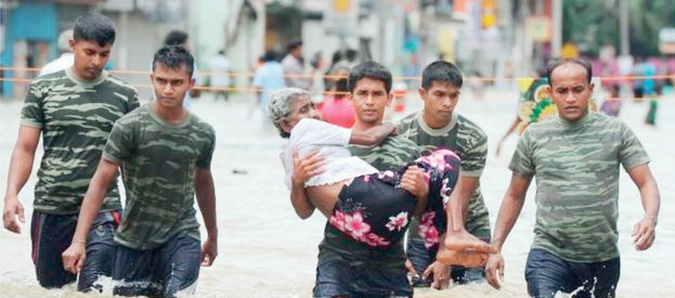
Over the desolate watery wastes,
Dulling the glow of the fabled Gem,
There opens a rainbow of opportunity,
For the peoples North and South,
To not only meet and greet,
But build a rock-solid bridge,
Of mutual help and solidarity,
As one undivided suffering flesh,
And we are moved to say urgently-
‘All you who wax so lyrically,
Of a united nation and reconciliation,
Grab this bridge-building opportunity.’
By Lynn Ockersz
-
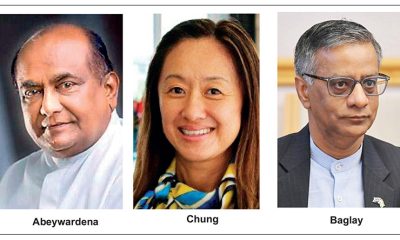
 Features6 days ago
Features6 days agoFinally, Mahinda Yapa sets the record straight
-
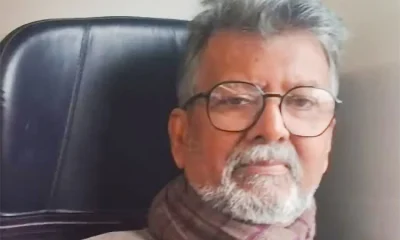
 News7 days ago
News7 days agoCyclone Ditwah leaves Sri Lanka’s biodiversity in ruins: Top scientist warns of unseen ecological disaster
-
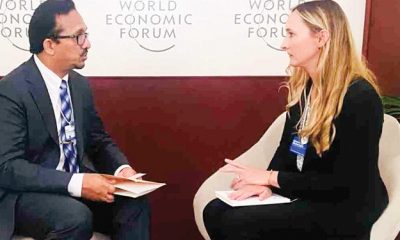
 Features6 days ago
Features6 days agoHandunnetti and Colonial Shackles of English in Sri Lanka
-
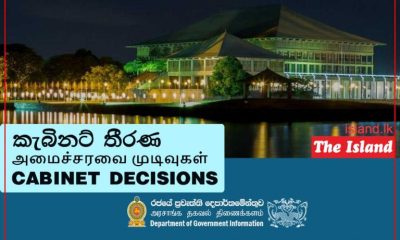
 Business4 days ago
Business4 days agoCabinet approves establishment of two 50 MW wind power stations in Mullikulum, Mannar region
-
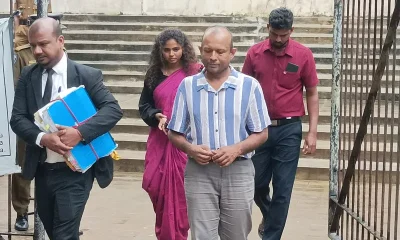
 News5 days ago
News5 days agoGota ordered to give court evidence of life threats
-
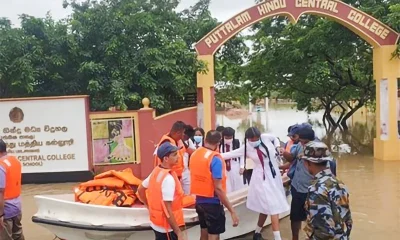
 Features7 days ago
Features7 days agoAn awakening: Revisiting education policy after Cyclone Ditwah
-

 Features5 days ago
Features5 days agoCliff and Hank recreate golden era of ‘The Young Ones’
-
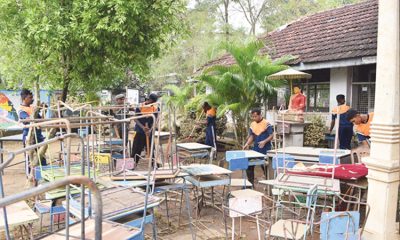
 Opinion6 days ago
Opinion6 days agoA national post-cyclone reflection period?













